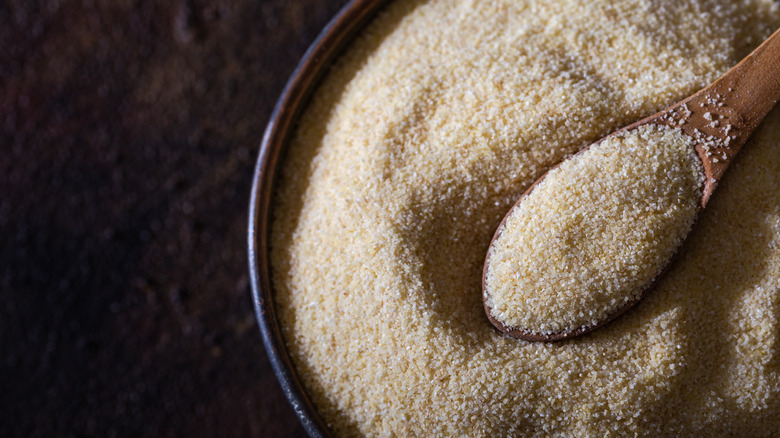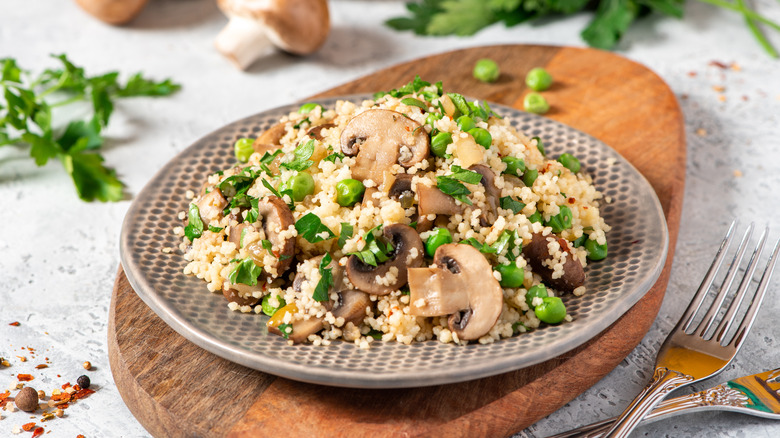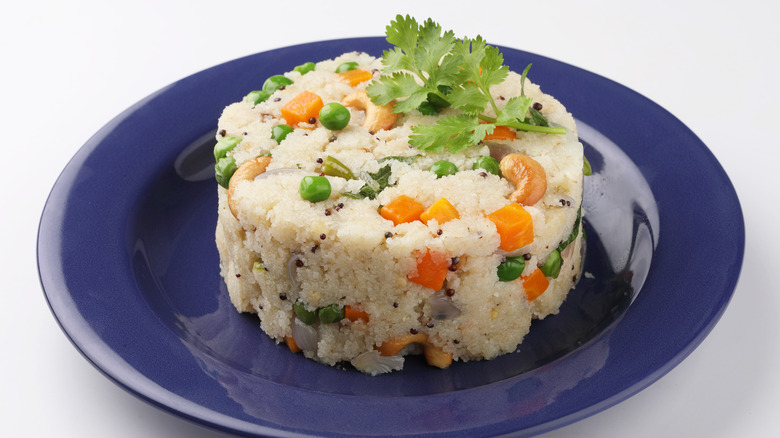What Is Semolina And How Is It Used?
We may receive a commission on purchases made from links.
Despite the probable infrequency with which you have encountered the word "semolina," you have almost certainly consumed food made from it. This is because it's the wheat foundation for most pasta. Even the pastas sold by Trader Joe's have semolina as its main ingredient.
Specifically, semolina is the ground grain of the durum wheat. Think grits, but grabbed from another species of wheat. Appreciate Goods explains that durum wheat, or Triticum Turgidum Durum, is the hardest wheat. This is why it is unimaginatively called durum, which is Latin for hard. On that note, semolina derives from the Latin word for flour. Semolina can also be ground further into the flour that makes pasta.
While, as Forbes notes, Northern Italy makes their pasta from softer wheat and eggs, the semolina used in the south is more pervasive. PBS credits this overwhelming preference to durum wheat's high gluten content and the fact that when dried, pasta made from durum wheat lasts indefinitely. These facts make semolina more favored by consumers. For the producers, the easy production process makes durum wheat a natural choice. All they need is to grind their wheat to semolina and add water.
Substitutes for semolina
You cannot really replace semolina. The wheat has earthy and aromatic aspects that make it stand out from the rest of the chaffs. However, the likelihood of you being forced to substitute semolina is low, as both Walmart and Amazon stock the flour. This is not some rare artisanal powder made by monks in the remotest peaks of the Himalayas. It is a relatively common ingredient.
But reality sometimes offers no alternative but to seek alternatives. The most straightforward replacement for semolina would be all purpose flour, which you can buy in the supermarket. The rest of their suggestions are all flours as well, with each type depending on what you are baking and why you are refraining from semolina. Almond flour, for example, works well for gluten free requirements. Pastry dough, on the other hand, results in fluffier baked products than the stodgy and filling durum wheat. But in terms of nutrition, Substitute Cooking gives semolina the crown as one of, if not the, healthiest wheat varieties.
It should be noted that there is also an ingredient called corn semolina. While you could substitute the two, corn semolina differs from wheat semolina in that it is ground corn, not ground durum. Despite the name, it may not be a better switch than straightforward flour.
What does healthiest wheat actually mean?
People who remember Scott Pilgrim's surprise at and fear over how bread fattens may be surprised at the idea of a particularly healthy wheat. However, as Healthline writes, unless you are intolerant of gluten or harbor a wheat allergy, semolina can bring health benefits, including the possibility of weight loss promotion. The relatively large amounts of fiber and protein within semolina mean that those who eat it feel less hungry later on. So, by instilling a lasting feeling of fullness, it could help cut down on habits like excessive snacking. The magnesium and iron in semolina can also contribute to a reduced risk of heart disease and improved blood sugar control.
So, with that health incentive in mind, you should find ways to incorporate reasonable amounts of the flour into your diet outside of pasta dishes. Even if it is simply sprinkled upon your potatoes as Healthline suggests, it will add a novelty to your flavors and a small, but present health benefit.
Semolina in Moroccan cuisine
So far, we've highlighted semolina as a core component of pasta, which is how most people have likely encountered it. However, as semolina is simply a type of flour, its uses proliferate when looked at in different cultures.
In Morocco, semolina or, as Moroccan Arabic calls it, smida, is mixed with flour and deployed to a variety of purposes extending far beyond pasta. These include soups flavored with saffron and anise, layered baklava, and various types of breads both baked and fried. The wheat is such a staple there that smida is used with the regularity with which we consider flour.
And, of course, smida is used for the most famous dish from Morocco: couscous. Morocco Sahara Tourism goes into great detail about how the durum wheat is prepared by hand with great ceremony. The preparations involve peeling raw semolina grain bits by hand with some olive oil. Then, cool water is added. The first step separates the semolina and the latter swells the grains, making them easier to cook. After a pause, the prepared semolina is repeatedly steamed for fifteen minute intervals, with butter being introduced in the last steaming.
Semolina in Indian cuisine
As in Morocco, India uses semolina for much more than pasta. Specifically, the ingredient is shown off in the country's breakfasts and desserts.
Upma, as Eater describes in the introduction to a recipe by the chef Chintan Pandya, is a traditional, porridge-like breakfast from western and southern India. Semolina serves as the base for the dish in which, after roasting the grain, you can customize it almost however you wish. Pandya's recipe is essentially: roast semolina in a dry pan, cook ingredients like tomatoes, onion, and curry leaves in ghee, then mix roasted semolina into the ghee cooked ingredients. Then, add yogurt for consistency. A similarly simple recipe by Denise D'silva Sankhé can be found on Serious Eats. It follows the same basic premise, sans yogurt and other garnishes.
At the end of the day, when porridge turns to pudding, there is sooji ka halwa, a semolina-based pudding. The dessert, the origin of which Taste Atlas states is Northern India and Pakistan, consists of semolina, a fattening ghee or oil, and a sweetener, usually honey or sugar. Other recipes include ingredients like cardamom pods and rose water for additional flavor. The basic recipe has the semolina cook in ghee until the grain turns golden brown. In a separate pot, cook sugar and water. Combine the two until the dish thickens, the liquid is absorbed, and you are left with a paste-like consistency.
Semolina in Nigerian cuisine
In Nigeria, semolina is one of many bases for fufu, a staple African dish that Okay Africa broadly defines as a starch rendered as a rich paste that's eaten by hand with stews and soups. The African Gourmet details the process of eating fufu, tearing portions away from the mound to help bring the stew to the mouth. It is never eaten as a meal unto itself.
Like every other recipe that relies upon semolina, the making of semolina fufu is relatively simple. The most complicated aspect is that you will see the words "semovita" and "semolina" used almost interchangeably. As Public Health Nigeria explains, semovita is a particular and popular brand of semolina sold in Nigeria. So, there are differences in how the brand is produced, but they belong to the same family. Semovita is easily procurable from stores that specialize in African groceries.
With that potential confusion put to rest, Afrolet provides a straightforward recipe. While you boil water, add the semovita to a separate cold water and stir the resulting mixture. Add the mixture to the boiling water and continue stirring until the mixture is elastic and without lumps. Voila!
Semolina in all its forms has proven a staple worldwide due to the ease with which it forms a solid, filling substance. If you are interested in incorporating semolina into your diet, you need not fear the unfamiliar name. Flour is flour.





